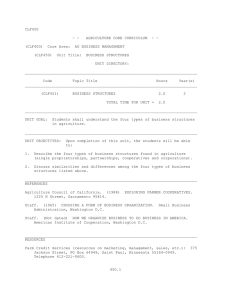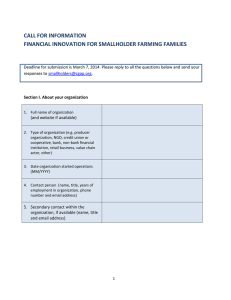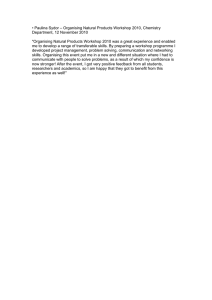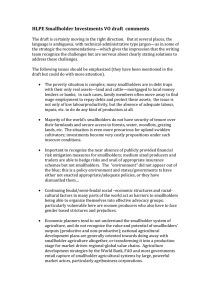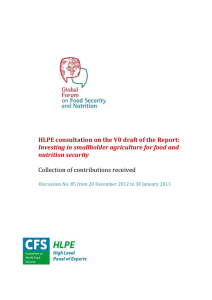ORGANISING WOMEN AND DEVELOPING LEADERSHIP WITH INFORMAL WOMEN WORKERS IN AGRICULTURE
advertisement
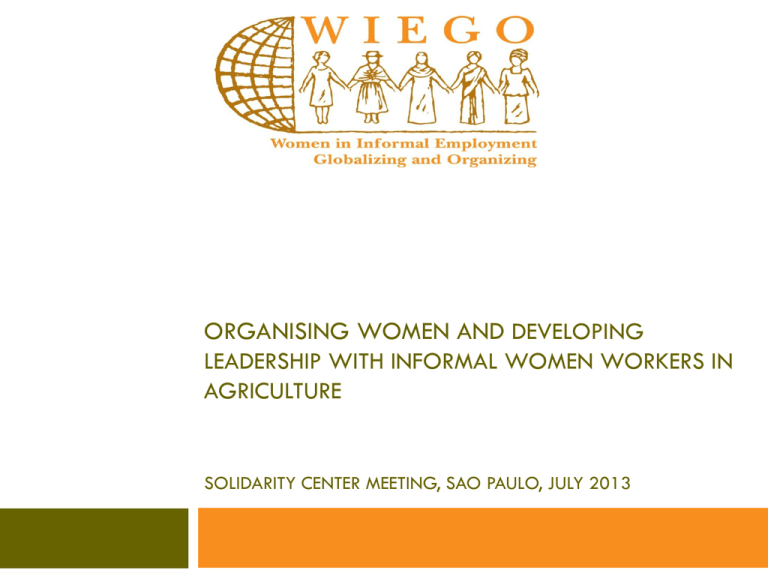
ORGANISING WOMEN AND DEVELOPING LEADERSHIP WITH INFORMAL WOMEN WORKERS IN AGRICULTURE SOLIDARITY CENTER MEETING, SAO PAULO, JULY 2013 Outline of presentation First we will look at different categories of informal workers in global agricultural value chains as this is an important consideration for the purpose of organising workers and their relative bargaining power Second, we will look at how own account workers organising in collective forms of enterprise can increase women’s economic empowerment and leadership Thirdly, we will look at the situation of women in smallholder production systems and how organising in cooperatives can improve women’s equality and participation in leadership positions Women in Agriculture The UN Food and Agriculture Organization estimates that women small-scale farmers in Africa own just 1 percent of agricultural land, receive only 7 percent of extension services, and less than 10 percent of agricultural credit is offered to women As much as 60 percent of the global agricultural workforce is made up of women (FAO at work 2010-2011: Women Key to Food Security) Yet women are over-represented in low paid jobs and underrepresented in higher paid jobs (SOFA Team & Cheryl Doss (2011).The role of women in agriculture, ESA Working Paper No. 11-02, FAO publication,p.2 http://www.fao.org/docrep/013/am307e/am307e00.pdf Different categories of informal workers in agriculture The categorisation is based on employment status depending on economic risk borne by the worker – key distinction is whether they are in “paid employment” or “self-employment” Paid employment is where worker holds explicit or implicit employment contract that gives them basic remuneration Self-employed workers in agriculture are further sub-divided based on degrees of economic risk and authority borne by the self-employed person (a) employers (b) own account operators (c) members of producer cooperatives and (d) contributing family members Informality is the norm rather than the exception in commodities and horticulture production systems and women suffer worse conditions than their male counterparts WIEGO’S DEFINITION OF WEE Empowerment refers to the process of change that gives working poor women – as individual workers and as members of worker organisations – the ability to gain access to the resources they need while also gaining the ability to influence the wider policy, regulatory and institutional environment that shapes their livelihoods and lives. The WIEGO project ….. How has collective organization empowered women? In depth case studies in seven countries found that women producers experienced significant improvements in their lives through participating in collective forms of enterprise and linking to Fair Trade markets Being organised into groups for production and trade increased their incomes and strengthened their ability to access productive resources and markets Enhanced status in households and communities The benefits of being organized Gained valuable skills and knowledge Improved experience in governing and managing their organisations As a result, they have greater confidence in their abilities and higher levels of self-esteem Women leaders have emerged who are capable of representing the voice of informal workers with government and policy-makers Organizations are linked into national, regional and global networks Key factors for success Capacity-building for strong women’s leadership Clear vision and mission with social as well as economic goals Good governance with commitment to democratic principles Commitment of group members key Formalization of groups gives access to banking and credit Skills development for technical up-grading and improved production Fair Trade networks provide links to markets Sharing experiences and building alliances provide a collective voice for women producers Women in Smallholder Production Systems Now we will look at the situation of women in smallholder production systems and how their situation can be improved through being organised in cooperatives – another category of informal worker Most smallholders in Global Agricultural Value Chains rely heavily on contributing family workers to meet the labour requirements for export production Women are often not compensated for their labour and receive little of the income and benefits derived from export production Cooperatives as vehicles for Improving Women’s Participation Collective organization can lead to economic and social empowerment and transformative leadership Certain conditions need to be met to ensure women’s full participation and assume leadership positions Ensure that membership criteria of cooperatives offer equal opportunities for women and men Avoid criteria such as land ownership or registrations, stipulating minimum production or harvest volumes or registering only heads of households Improving women’s participation in cooperatives Consider a quota system for improved representation of women in leadership positions e.g. Kuapa Kokoo and Gumutindo Encourage men to give a share of their land to their wives Encourage more equal sharing of income, labour inputs and decision-making between husbands and wives Ensure that contributing women family workers benefit from training provided under any capacity-building programmes Ensure that contributing family workers benefit from new processing activities introduced through value chain programmes Smallholder farmers as employers Finally, how to deal with the question of labour standards with smallholders who are employers Educate smallholders and their employees about workers’ rights Some value chain programmes make it a condition of participation that smallholders respect the rights of hired workers as is also the case with certification systems Providing good working conditions for hired workers brings benefits to smallholders as well as their workers Trading Our Way Up: Women Organising for Fair Trade http://www.wiego.org
